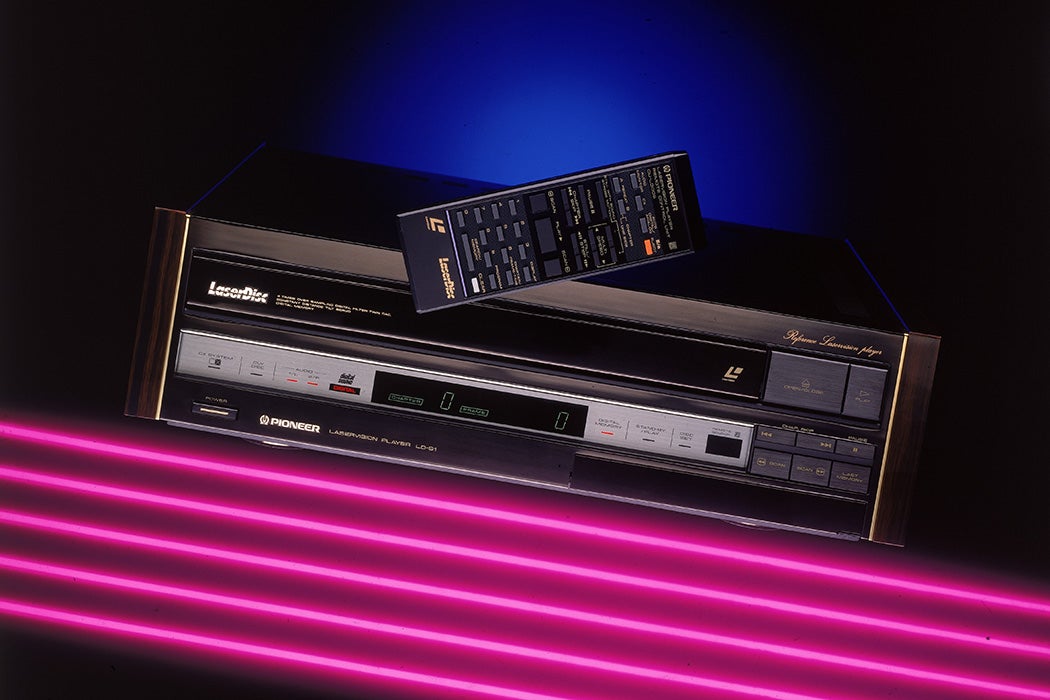From cassettes to CDs. Transistor radios to mp3 players. Television antennas to streaming. Our technological graveyards are full of reminders of how we’ve entertained ourselves. And for home viewing, the early videodisc format, like the laserdisc, were fighting for space in living rooms worldwide.
It’s 1978. The world has just been introduced to DiscoVision, a system for home-media viewing developed by Magnavox Consumer Electronics (MCA). Four years earlier, Science had reported on MCA’s plans to build and market a “laser-based system as early as 1976 for as little as $500.” According to Science, “Video disk systems are believed by many in the industry to be the next major breakthrough in the trade, and one which will boost the business in the 1970’s the way color TV did in the 1960’s.” As developed, the system used a low-powered laser to read information from a rapidly spinning (1,800 revolutions per minute, according to the New York Times) plastic and aluminum disc. Each disc stored an hour of footage. MCA DiscoVision was the newest in a long line of technologies that were going to change the way we viewed media.
The ability to view things at home, or even at your leisure, was becoming the next frontier. VCRs allowed home-viewing of pre-recorded tapes, and the recording feature was leading to “time shifting,” a term coined by Sony chairman Akio Morita, that essentially meant that you could record a program at eight p.m. on a Thursday and watch it whenever you felt like it. The TV schedule meant nothing. And that was a problem. Part of the appeal of laser technology for the media companies was that laserdiscs weren’t recordable. As film critic Roger Ebert pointed out, MCA hoped the tech “would forestall VHS and Beta videotapes.”
In 1981, media company RCA took things a step further with SelectaVision. It wasn’t a laserdisc system, but its demise is often lumped in with that of the laserdisc. SelectaVision functioned more like a record player. It used “a diamond-tipped stylus to read the grooves of twelve-inch plastic capacitance electronic discs (CEDs) […] via conductive vinyl platters,” researchers Jimi Jones and Landon Palmer explain. It also had a hint of the curatorial, unlike the laserdisc. Viewers could pause, move to exact locations, and watch things in the order they chose. “Consumers can now program their own video concerts, something they can’t do with video cassette recorders,” RCA division vice president Thomas G. Kuhn said in 1983.
Early versions of the SelectaVision system disc held only fifteen to thirty minutes of content, and so music videos were one of the first offerings. As Jones and Palmer note, D. A. Pennebaker’s 1983 film about David Bowie, Ziggy Stardust and the Spiders from Mars, “began as a project commissioned for a twenty-minute SelectaVision concert film.” Others, such as Frank Sinatra and promoter Don Kirshner, made agreements for SelectaVision concerts. They were “cover[ing] the cultural map to the tune of $50 million in programming investment in the hope of creating a library that included, as an internal memo enumerated, ‘Wagner and Westerns.’”
Weekly Newsletter
It wasn’t a good investment, as it turns out; the system went on sale in the US in 1981 and was discontinued in 1984. As Jones and Palmer write, “RCA’s total loss since the introduction of the technology to the market three years earlier was $580 million.” Workers found out that the CED plant was going to be closed from a news report on the nightly news. And memories of it were lost, too. Ebert points out, “the collapse of the RCA videodisc system was so thoroughly publicized that to this day…many people still remember it—and confuse the extinct system with laserdiscs.”
Read This Next
The Importance of Technological Change in Shaping Generational Perspectives
Laserdiscs met their own end due to both their high cost (the system was priced from $350 to more than $2,000 according to Ebert, with disc prices around $40) and the emergence of formats that were able to store more content in a smaller form. Though, as Ebert explains, “laserdiscs almost got dragged down in the RCA collapse, in a sort of guilt by association,” the format was popular through the 1990s. Though these formats ultimately “failed,” they signaled that consumers were hungry for control of their home entertainment.








